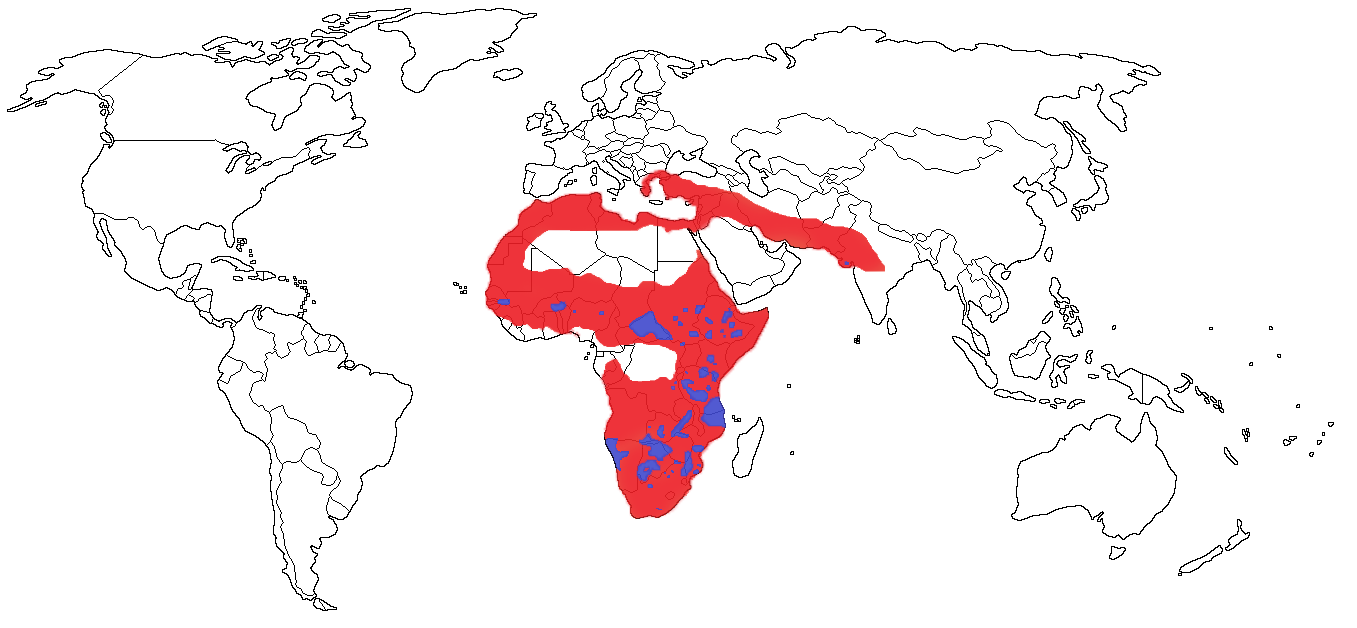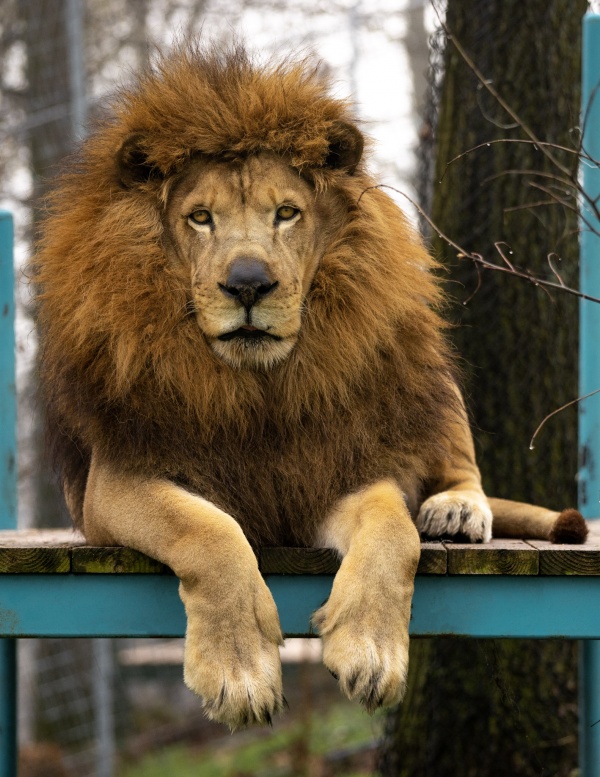
Taxonomy
Kingdom: Animalia
Phylum: Chordata
Class: Mammalia
Order: Carnivora
Family: Felidae
Genus: Panthera
Species: leo
Scientific Name: Panthera leo
IUCN Red List: Endangered
About
Habitat: Lions are found primarily in savannas, but they can occur in all habitats in Africa. The preferred habitats are open woodlands and thick bush, scrub, and grass areas. In Asia, lions are found in dry deciduous forests of India’s Gir National Forest. To best avoid people, lions prefer moist, mixed, and shady habitats for optimal cover.

Territoriality: As the only social feline species, lions live in large groups called prides that consist of multiple females, their cubs, and two or three male lions in a territory averaging 100 square miles. It is the male’s sole job to protect the pride and their territory. He does this by scent marking, scratching, and caroling, this is a form of roar that can be heard up to 5 miles away. This caroling is used to communicate with other members of the pride, as well as warn surrounding competing males. Infanticide is common to increase new male’s chances of successfully breeding with a female. The average range size of lion prides in Africa is 10 to 87 square miles, while lions in India have a range of 13 to 33 square miles.
Lifespan:
In the wild: 10 to 18 years
In captivity: Up to 30 years
Population:
African Lion: About 23,000-38,000 individuals
Asiatic Lion: About 500 individuals
Physical Description
Weight: 265 – 420 pounds
Length: 4.5 – 8.2 ft (nose to tail)
Lions are the second largest big cat and are the largest carnivore found in Africa. They have short, coarse fur that is yellow. Lions are sexually dimorphic as the males typically weigh 20-27 percent more than females. The male lions have a thick mane around their head, neck, and chest that ranges in color from tawny to dark brown, depending on their testosterone level. Lions found in India, are typically smaller than those found in Africa. Unique to these lions, is a longitudinal fold of skin that runs along the belly. Male lions in this region have smaller manes compared to the Africa population, allowing their ears always to be visible.
History
Lions used to be one of the most widely ranging cat species. Historically, their range covered the majority of continental African countries, stretched from Greece into eastern Europe, southwest Asia, and India. The lion range of today is only a fraction of what it once was in the past. In Europe, lions were extirpated nearly 2,000 years ago; lions in southwest Asia within the last 150 years; and in northern Africa in the 1940s. Todays’ lions are only found in Asia and sub-Saharan Africa. Those in Asia remain only Gir National Forest of India, while those in Africa are located in 35 countries across the continent.
Lions in Asia are now being found outside of the protected areas. They have had a population growth of about 126% in the last two decades, with close to 30% living outside protected areas. However, they are still close to human populations. Their numbers have risen to about 500 individuals from the approximately 50 in the early 19th century and are no longer listed as Critically Endangered. They are now classified as Endangered on the IUCN Red List.
In Africa, lions have lost nearly half of their populations since the 1950s. But, in the 20 years between 1995 and 2015, populations were falling at a steady rate. While numbers are still declining, there are several conservation efforts and wildlife areas devoted to the increase of populations and genetic diversity of lions in Africa.

Reproduction
Gestation Period: 110 days
Litter size: 1 to 4 cubs (3 to 4 average)
There is no definitive breeding season for lions. If a female raises her cubs successfully to maturity, she will reproduce every 20 months. However, if a litter is lost, females can reproduce within four to six months. A female will wait to introduce her cubs to the pride until they are six to eight weeks old. Then, cubs will be cared for collectively by all of the females in the pride. Females will not mate with a male outside of the pride; if a new male wins dominance of the pride, they will breed with the new dominant male.
Fun Facts
- The darker the lion’s mane, the more dominate the male
- Most social of the cat species
- Lions have the largest eyes of all the meat-eaters
- Eastern Africa has approximately 40% of all the lions in Africa
Diet and Hunting Behavior
Lions are opportunistic hunters and scavengers. Being larger and more dominant, they can easily force out other predators from their kills. As the largest feline in Africa, they are heavily dependent on a successful hunt to feed the pride. Being so large, they have been known to eat 100 pounds of meat at one time. To keep up with this extreme appetite, they typically target large ungulates as their prey. However, they are generalists and have been known to hunt virtually every mammal species larger than half a pound in their area. Lions will hunt at night during the cooler temperatures and hunt prey such as zebras, wildebeest, springboks, and other hoofstock. The lionesses will hunt while the male protects the territory from intruders. They are ambush predators that will form a circle around the prey and attack as a group. When a kill has been made, the male lion will eat first, followed by the females and cubs.
Threats and Conservation
While most lions today live in protected areas, poor management, lax law enforcement, and increased pressure to support human agricultural needs are still affecting lion populations. Increasing human populations are pushing towards protected area borders, to meet spatial and agricultural needs, also increasing human and wildlife conflict. Conservation efforts and population management plans are being enacted to help stabilize lion populations and protect their habitats. Currently, west and central African populations are listed as Critically Endangered, and populations in southern Africa are Vulnerable by the IUCN Redlist
Habitat loss and degradation remain one of the greatest threats to lion populations in Africa. Lions have lost over 90% of their historic range. Human expansion and development impact even protected areas and the populations of lions that reside there. However, the lion populations found in India are beginning to rise. While they were initially located in a protected area of around 100 square kilometers, they have started expanding outside of these bounds. They can now be found in a territory of over 10,000 square kilometers. While this expansion might be located outside of the protected area, local farming and agricultural development have been encouraged, creating refuge areas and corridors for the movement of lions.
The growth of human populations has led to many human-lion conflicts. These conflicts are primarily seen on the edge of protected areas where livestock graze or when lions move out of these areas in search of prey, often preying on domestic livestock. This leads to indiscriminate killing of lions as retaliation or preemptive measures to protect the lives of humans and livestock. In high conflict areas, the animal responsible is difficult to identify, and a token animal may be killed instead, leaving the problem lion to continue to attack, leading to more retaliatory killings.
The abundance of prey is the most essential requirement for a carnivore to survive, as it affects reproduction, recruitment, and foraging behavior. In most African countries, unsustainable and increasingly commercialized bushmeat hunting of the lion’s prey puts the carnivore under threat. In India, prey abundance is not a concern for the population, as conservation initiatives have ensured the availability of ample prey. Lions play a vital and irreversible role in the ecosystems of Africa. As apex predators, they balance the necessary predator-prey equilibrium. Lions control dominant herbivore species such as zebras and buffalos, who could outcompete other herbivores if not regulated by the apex predator.
Not only is there an increase in bushmeat hunting of lion prey but also the lions themselves. Their body parts are sold to markets within Africa and Asia for traditional medicines. Unsustainable and rampant trophy hunting sparks a cause for concern for the future of the species. It contributes to population declines when poorly regulated. However, when sustainably and scientifically managed, trophy hunting can be beneficial to particular subpopulations of lions and also local communities by increasing community education, lessening retaliatory killings, and relieving competitive habitat pressure.
Punishing those who hunt lions as a source of food without providing an alternative protein source will not fix the problem. However, ensuring that locals have enough access to protein, teaching them how to maintain livestock, and also providing cheap ways to obtain protein, will. By inspiring communities and providing them with other food resources, these communities that once hunted lions will formulate a positive relationship with lion conservation for future generations, and thereby become a part of the solution.
Strengthening protected areas for wild lions is extremely important for their survival, and also requires massive public and financial support. Securing land for lion populations will ensure their long-term survival, as well as protect many other species that reside on the same land. The current protected area for lions is 1.51 million square kilometers, which is twice the size of Texas. However, this area is extremely underfunded. By increasing protected areas for lions, the support for conservation efforts will increase, create job opportunities, attract tourism, and help the economy. Increasing collaborations with non-governmental organizations and state wildlife authorities will help provide long-term funding opportunities and conservation support.
